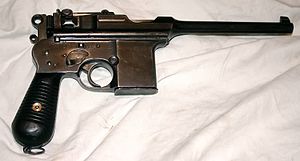
A machine pistol is a handgun that is capable of fully automatic fire, including stockless handgun-style submachine guns.
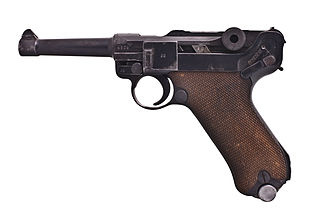
The Pistole Parabellum or Parabellum-Pistole, commonly known as just the Luger or Luger P08, is a toggle-locked recoil-operated semi-automatic pistol. The Luger was produced in several models and by several nations from 1898 to 1949.
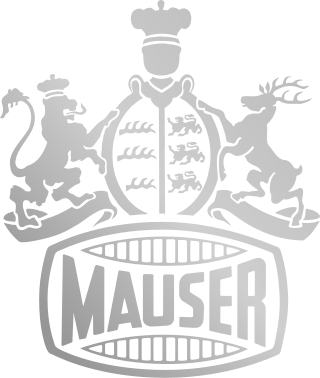
Mauser, originally the Königlich Württembergische Gewehrfabrik, was a German arms manufacturer. Their line of bolt-action rifles and semi-automatic pistols was produced beginning in the 1870s for the German armed forces. In the late 19th and early 20th centuries, Mauser designs were also exported and licensed to many countries, which adopted them as military and civilian sporting firearms. The Gewehr 98 in particular was widely adopted and copied, becoming one of the most copied firearms designs and it is the foundation of many of today's sporting bolt-action rifles. Around 10 million Gewehr 98 style rifles were produced.

The Mauser C96 is a semi-automatic pistol that was originally produced by German arms manufacturer Mauser from 1896 to 1937. Unlicensed copies of the gun were also manufactured in Spain and China in the first half of the 20th century.

A semi-automatic pistol is a repeating handgun that automatically ejects and loads cartridges in its chamber after every shot fired, but only one round of ammunition is fired each time the trigger is pulled. The pistol's fire control group disconnects the trigger mechanism from the firing pin/striker until the trigger has been released and reset manually, unlike the self-cycled firing mechanism in fully automatic pistols.

The 7.62×25mm Tokarev cartridge is a Soviet rimless bottleneck pistol cartridge widely used in former Soviet states and in China, among other countries. The cartridge has since been replaced in most capacities by the 9×18mm Makarov in Russian service.
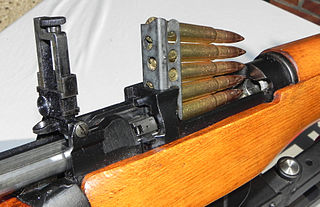
A stripper clip is a speedloader that holds several cartridges together in a single unit for easier and faster loading of a firearm magazine.

The Rubypistol was a semi-automatic pistol of .32 ACP calibre made by Gabilondo y Urresti and other Spanish companies. It saw use in both World Wars as the service weapon of the French Army under the name Pistolet Automatique de 7 millim.65 genre "Ruby".

The Stechkin or APS is a Soviet selective fire machine pistol that is chambered in 9×18mm Makarov and 9×19mm Parabellum. It was introduced into service in 1951 for use by artillery and mortar crews, tank crews and aircraft personnel, for whom a cumbersome assault rifle was deemed unnecessary, and saw service in a number of wars including the Vietnam War, Russo-Ukrainian War and Syrian Civil War. The APS was praised for its innovative concept and good controllability for its size. However, the high cost of the weapon, complex and time-consuming machining, combined with a limited effective range, large size and weight for a pistol, and fragile buttstock have been mentioned as a reason to phase it out of active service in favour of assault rifles such as the AKS-74U. The pistol bears the name of its developer, Igor Stechkin.

A handgun is a firearm designed to be usable with only one hand. It is distinguished from a long barreled gun which typically is intended to be held by both hands and braced against the shoulder. Handguns have shorter effective ranges compared to long guns, and are much harder to shoot accurately. While most early handguns are single-shot pistols, the two most common types of handguns used in modern times are revolvers and semi-automatic pistols.

Astra Unceta y Cía was a Spanish weapons manufacturer founded on 17 July 1908, under the name Esperanza y Unceta by Juan Esperanza and Pedro Unceta. Initially based in Eibar, the centre of the Basque arms industry, the company moved in 1913 to Guernica.

The 9×25mm Mauser is a cartridge developed for the Mauser C96 service pistol around 1904 by DWM. Mauser pistols in this relatively powerful caliber were primarily intended for export to Africa, Asia, and South America. The 9mm Mauser Export cartridge was produced specifically for Mauser pistols and carbines made from 1904 to 1914 and then later from approximately 1930 to 1945 for submachine guns chambered for this caliber.
The Astra modelo 400 was a Spanish service pistol produced by weapons manufacturer Astra-Unceta y Cia SA as a replacement for the Campo-Giro 1913/1916, which had also been chambered in 9mm Largo. It was the standard issue sidearm in the Spanish Army during the Spanish Civil War and also saw service in Germany during World War II.

The Bergmann 1894/1896/1897 was a family of 19th-century semi-automatic pistols developed by German designer Louis Schmeisser and sold by Theodor Bergmann's company.
The Type 80 is a close-combat machine pistol that was used in China in the 1980s by the People's Liberation Army of China. It was developed by Norinco in the 1970s, influenced by the design of the German M712 Schnellfeuer.

The Bergmann–Bayard was a German-designed recoil operated semi-automatic pistol produced under license in Belgium.
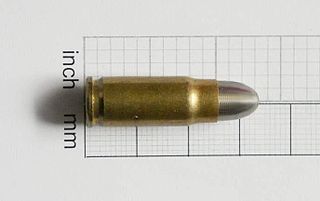
The 7.63×25mm Mauser round is a bottleneck, rimless, centerfire cartridge, originally developed for the Mauser C96 service pistol. This cartridge headspaces on the shoulder of the case. It later served as the basis for the 7.62mm Tokarev cartridge commonly used in Soviet and Eastern Bloc weapons.

The Modelo 1905 is a pistol designed by Ferdinand Ritter von Mannlicher in 1899 and originally produced in Austria as the Mannlicher Model 1901. The Mannlicher Model 1901 was an improved version of the Model 1900, both of which were produced by Österreichische Waffenfabriks-Gesellschaft. All of these models have the same basic design and operation, but minimal adjustments were made to improve each of them. The Modelo 1905 is the version of the Model 1901 that the Argentine Army purchased from Steyr in 1905. This semi-automatic pistol has a unique and elegant appearance due to the curve of the handgrip. It is single action and uses a blowback operation system to reload. Like its predecessors, the Modelo 1905 has a non-detachable magazine that can be loaded from the top with a stripper clip.
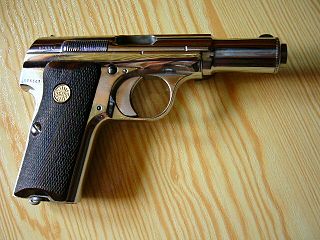
The Astra 300 was a Spanish semi-automatic pistol manufactured by Astra Unceta from 1922 to 1946.
